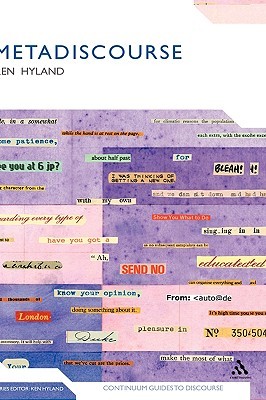
- We will send in 10–14 business days.
- Author: Ken Hyland
- Publisher: CONTINNUUM 3PL
- ISBN-10: 0826476104
- ISBN-13: 9780826476104
- Format: 16.1 x 24.2 x 2.4 cm, kieti viršeliai
- Language: English
- SAVE -10% with code: EXTRA
Reviews
Description
This book addresses an important aspect of how language is used in written communication: the ways that writers reflect on their texts to refer to themselves, their readers or the text itself. This is known as METADISCOURSE. Metadiscourse is a key resource in language, as it allows the writer to engage with readers in familiar and expected ways. Writers use the devices of metadiscourse to adjust the level of personality in their texts, to offer a representation of themselves and their arguments. This helps the reader organise, interpret and evaluate the information presented in the text. Metadiscourse is therefore crucial to successful communication. Knowing how to identify metadiscourse as a reader is a key skill to be learnt by students of discourse analysis. Learning how to use metadiscourse in writing is an important tool for students of academic writing in both the L1 and L2 context. This book has four main purposes: - to provide an accessible introduction to metadiscourse, discussing its role and importance in written communication and reviewing current thinking on the topic. - to explore examples of metadiscourse in a range of texts from business, academic, journalistic, and student writing - to offer a new theory of metadiscourse - to show the relevance of this theory to students, academics and language teachers.
EXTRA 10 % discount with code: EXTRA
The promotion ends in 23d.06:20:34
The discount code is valid when purchasing from 10 €. Discounts do not stack.
- Author: Ken Hyland
- Publisher: CONTINNUUM 3PL
- ISBN-10: 0826476104
- ISBN-13: 9780826476104
- Format: 16.1 x 24.2 x 2.4 cm, kieti viršeliai
- Language: English English
This book addresses an important aspect of how language is used in written communication: the ways that writers reflect on their texts to refer to themselves, their readers or the text itself. This is known as METADISCOURSE. Metadiscourse is a key resource in language, as it allows the writer to engage with readers in familiar and expected ways. Writers use the devices of metadiscourse to adjust the level of personality in their texts, to offer a representation of themselves and their arguments. This helps the reader organise, interpret and evaluate the information presented in the text. Metadiscourse is therefore crucial to successful communication. Knowing how to identify metadiscourse as a reader is a key skill to be learnt by students of discourse analysis. Learning how to use metadiscourse in writing is an important tool for students of academic writing in both the L1 and L2 context. This book has four main purposes: - to provide an accessible introduction to metadiscourse, discussing its role and importance in written communication and reviewing current thinking on the topic. - to explore examples of metadiscourse in a range of texts from business, academic, journalistic, and student writing - to offer a new theory of metadiscourse - to show the relevance of this theory to students, academics and language teachers.


Reviews